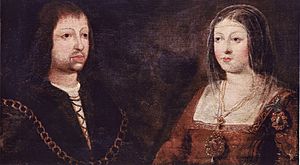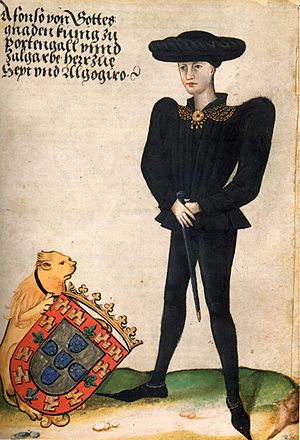Treaty of Alcáçovas facts for kids
The Treaty of Alcáçovas (also called the Peace of Alcáçovas-Toledo) was an important agreement signed on September 4, 1479. It was signed between the rulers of Castile and Aragon, Queen Isabella and King Ferdinand, and King Afonso V of Portugal and his son, Prince John.
This treaty officially ended the War of the Castilian Succession. In this war, Castile won on land, but Portugal was stronger at sea. The treaty showed this outcome. Isabella was recognized as the Queen of Castile. Portugal gained a lot of power in the Atlantic Ocean.
The treaty helped to sort out several important things:
- King Afonso V gave up his claim to the Castilian throne. Isabella and Ferdinand gave up their claims to the Portuguese throne.
- The Atlantic Ocean and new lands were divided into two areas of control.
- It decided what would happen to Juana de Trastámara, who was also claiming the Castilian throne.
- It arranged a marriage between Isabella, the daughter of the Castilian rulers, and Afonso, the heir to the Portuguese throne. This part was known as the Tercerias de Moura. It also included a payment from Castile to Portugal as part of the marriage dowry.
- It pardoned Castilian people who had supported Juana during the war.
Contents
The War for the Castilian Throne
After King Henry IV of Castile died in 1474, there was a fight over who would be the next ruler. The two main people claiming the throne were King Henry's half-sister, Isabella I of Castile, and his daughter, Juana de Trastámara. Juana was often called "la Beltraneja" because some people thought her real father was Beltrán de la Cueva.
A civil war started in Castile. Afonso V of Portugal married Juana and invaded Castile in May 1475 to support her claim.
At the same time, Portugal and Castile were fighting a fierce naval war. They both wanted to control new lands and trade routes across the ocean. They especially wanted control of Guinea, which was rich in gold and other valuable resources.
Key battles in this war included the battle of Toro on March 1, 1476. This battle did not have a clear winner, but Castile used it as a strategic victory. The battle of Guinea in 1478 gave Portugal control of the Atlantic Ocean and the disputed territories.
What the Treaty Achieved
The Treaty of Alcáçovas had several important results:
- Juana de Trastamara and King Afonso V gave up their claims to the Castilian throne. This meant Isabella and Ferdinand were officially recognized as the rulers of Castile. In return, Isabella and Ferdinand gave up their claims to the Portuguese throne.
- The treaty divided the Atlantic territories between Portugal and Castile. It set clear areas where each country could explore and claim land.
- Most of the lands and coasts that Portugal and Castile had been fighting over went to Portugal. These included Guinea (with its gold mines), Madeira, the Azores, and Cape Verde. Portugal also gained the only right to conquer the Kingdom of Fez in North Africa.
- Castile's rights over the Canary Islands were confirmed. However, Portugal gained the exclusive right to sail, conquer, and trade in all parts of the Atlantic Ocean south of the Canary Islands. This gave Portugal a very strong position in the Atlantic for both known and future discoveries. Castile was mostly limited to the Canary Islands.
- Portugal received a payment of 106,676 gold coins from Castile. This was given as part of Isabella's marriage dowry.
- The young children involved in the marriage agreement, Isabella (Castilian) and Afonso (Portuguese), stayed in Portugal. They lived in the village of Moura under a special arrangement called Tercerias until they were old enough to marry. Castile paid for all their living costs.
- Juana had to choose between living in Portugal and joining a religious order (like becoming a nun), or marrying Prince Juan, the son of Isabella and Ferdinand. She chose to join a religious order.
- All the Castilian people who had supported Juana and Afonso during the war were pardoned.
Dividing the World's Possessions
This treaty was later confirmed by a special paper from the Pope called Aeterni regis in 1481. It basically allowed Portugal to continue exploring along the African coast. It also made sure Castile kept control of the Canary Islands. The treaty also said that Castilians could not sail to Portuguese lands without Portugal's permission.
The Treaty of Alcáçovas ended a time of fighting. But it also set the stage for future claims and disagreements.
Castile had been slower than Portugal to explore the Atlantic. It wasn't until the late 1400s that Castilian sailors started to compete with their neighbors. Their first big competition was for the Canary Islands, which Castile won.
After the kingdoms of Aragon and Castile joined together, and the Reconquista (the Christian reconquest of Spain) was finished, the larger country of Spain became very interested in finding new trade routes and colonies. In 1492, the rulers of Spain decided to fund Christopher Columbus's journey. They hoped he could find a way to Asia by sailing west across the Atlantic, bypassing Portugal's control over Africa and the Indian Ocean.
A First Step in International Law
The Treaty of Alcáçovas was the first document to clearly mark out areas for future discoveries for Spain and Portugal. It specifically defined "the rights of the two crowns over the territories of the African Continent and the Atlantic islands." Because of this, it is seen as a very important moment in the history of colonialism.
It was one of the first international agreements to formally state that European powers could divide the rest of the world into "spheres of influence." This meant they could claim and colonize territories within these areas. The treaty did not require the indigenous peoples living there to give their permission. This idea was generally accepted by European powers until the 20th century, when many colonies gained independence.
The Treaty of Alcáçovas can be seen as the ancestor of many later international treaties. These include the 1494 Treaty of Tordesillas, which further divided the world between Spain and Portugal. It also relates to the 1884 Conference of Berlin, which, centuries later, divided Africa into colonial areas in a similar way.
See also
 In Spanish: Tratado de Alcazobas para niños
In Spanish: Tratado de Alcazobas para niños
- List of treaties



